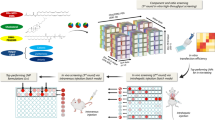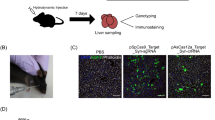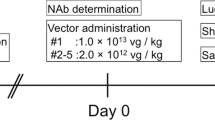Abstract
There are many problems associated with plasmid DNA that may limit its use in systemic gene transfer. These problems could be solved by the use of synthetic genes. As a model to test the feasibility of using synthetic genes for gene therapy, we PCR-amplified a fragment containing the CMV promoter, the luciferase gene and a polyadenylation signal. The in vivo expression efficiency of the PCR fragment was determined by using two different methods, a hydrodynamics-based gene transfer of naked DNA to the liver and LPD (a lipid-based vector) mediated gene transfer to the lung. Our results show that linear fragments are at least as active as plasmid DNA following systemic delivery by LPD. However, PCR fragments are much less inflammatory than plasmid DNA as shown by a three-fold reduction in serum levels of both TNF-α and IL-12. Our results also showed that PCR fragments are highly efficient in liver gene transfer following systemic administration in a large volume. Thus, these results support the idea of using synthetic genes for gene therapy. Since gene sequence can be easily obtained as a PCR fragment, our results also imply that it may provide a useful and convenient method for determining the physiologic function of a putative gene in intact animals.
This is a preview of subscription content, access via your institution
Access options
Subscribe to this journal
Receive 12 print issues and online access
$259.00 per year
only $21.58 per issue
Buy this article
- Purchase on Springer Link
- Instant access to full article PDF
Prices may be subject to local taxes which are calculated during checkout




Similar content being viewed by others
References
Li S, Huang L . Nonviral gene therapy: promises and challenges Gene Therapy 2000 7: 31–34
Tseng W-C, Huang L . Liposome based gene therapy Pharm Sci Tech Today 1998 1: 206–213
Raetz CRH . Biochemistry of endotoxin Annu Rev Biochem 1990 59: 129–170
Engelhardt R, Mackensen A, Galanos C . Phase I trial of intravenously administered endotoxin (Salmonella abortus equii) in cancer patients Cancer Res 1991 51: 2524–2430
Weber M, Moleer K, Welzeck M, Schorr J . Short technical reports. Effects of lipopolysaccharide on transfection efficiency in eukaryotic cells Biotechniques 1995 19: 930–940
Krieg AM . Direct immunologic activities of CpG DNA and implications for gene therapy J Gene Med 1999 1: 56–63
Pisetsky DS . The influence of base sequence on the immunostimulatory properties of DNA Immunol Res 1999 19: 35–46
Krieg AM . An innate immune defence mechanism based on the recognition of CpG motifs in microbial DNA J Lab Clin Med 1996 128: 128–133
Bird AP . CpG rich islands and the function of DNA methylation Nature (London) 1986 321: 209–213
Krieg AM et al. CpG motifs in bacterial DNA trigger direct B cell activation Nature 1995 374: 546–549
Ballas ZK, Rasmussen WL, Krieg AM . Induction of NK activity in murine and human cells by CpG motifs in oligodeoxynucleotides and bacterial DNA J Immunol 1996 157: 1840–1845
Klinman DM et al. CpG motifs present in bacterial DNA rapidly induce lymphocytes to secrete interleukin 6, interleukin 12, and interferon-γ Proc Natl Acad Sci USA 1996 93: 2879–2883
Sparwasser T et al. Macrophage sense pathogens via DNA motifs: induction of tumor necrosis factor-α mediated shock Eur J Immunol 1997 27: 1671–1679
Whitmore M, Li S, Huang L . LPD lipopolyplex initiates a potent cytokine response and inhibits tumor growth Gene Therapy 1999 6: 1867–1875
Tan Y, Li S, Pitt BR, Huang L . The inhibitory role of CpG immunostimulatory motifs in cationic lipid vector-mediated transgene expression in vivo Hum Gene Ther 1999 10: 2153–2161
Brouckaert PG et al. In vivo anti-tumour activity recombinant human and murine TNF, alone and in combination with murine IFN-gamma, on a syngeneic murine melanoma Int J Cancer 1986 38: 763–769
Qin L et al. Promoter attenuation in gene therapy: interferon-gamma and tumor necrosis factor-alpha inhibit transgene expression Hum Gene Ther 1997 8: 2019–2029
Li S, Brisson M, He Y, Huang L . Delivery of a PCR amplified DNA fragment into cells: a model for using synthetic genes for gene therapy Gene Therapy 1997 4: 449–454
Li S, Huang L . In vivo gene transfer via intravenous administration of cationic lipid–protamine–DNA (LPD) complexes Gene Therapy 1997 4: 891–900
Yew NS et al. Reduced inflammatory response to plamid DNA vectors by elimination and inhibition of immunostimulatory CpG motifs Mol Ther 2000 1: 1–8
Li S et al. Effect of immune response on gene transfer to the lung via systemic administration of cationic lipidic vectors Am J Physiol 1999 276: L796–L804
Robbins PD, Tahara H, Ghivizzani SC . Viral vectors for gene therapy Trends Biotechnol 1998 16: 35–40
Miller AD, Miller DG, Garcia JV, Lynch CM . Use of retroviral vectors for gene transfer and expression Meth Enzymol 1993 217: 581–599
Wolff JA et al. Direct gene transfer into mouse muscle in vivo Science 1990 247: 1465–1468
Hickman MA et al. Gene expression following direct injection of DNA into liver Hum Gene Ther 1994 5: 1477–1483
Zhang GE et al. Expression of naked plasmid DNA injected into the afferent and efferent vessels of rodent and dog livers Hum Gene Ther 1997 8: 1763–1772
Budker V, Zhang G, Knechtle S, Wolff JA . Naked DNA delivery intraportally expresses efficiently in hepatocytes Gene Therapy 1996 3: 593–598
Meyer KB et al. Intratracheal gene delivery to the mouse airway: characterization of plasmid DNA expression and pharmacokinetics Gene Therapy 1995 2: 450–460
Li K, Welikson RE, Vikstrom KL, Leinwand LA . Direct gene transfer into the mouse heart J Mol Cell Cardiol 1997 29: 1499–1504
Chaote KA, Khavari PA . Direct cutaneous gene delivery in a human genetic skin disease Hum Gene Ther 1997 8: 1659–1665
Liu F, Song YK, Liu D . Hydrodynamics-based transfection in animals by systemic administration of plasmid DNA Gene Therapy 1999 6: 1258–1266
Zhang G, Budker V, Wolff JA . High levels of foreign gene expression in hepatocytes after tail vein injections of naked plasmid DNA Hum Gene Ther 1999 10: 1735–1737
Rommerskirch W, Graeber I, Grassmann M, Grassmann A . Homologous recombination of SV40 DNA in COS7 cells occurs with high frequency in a gene dose independent fashion Nucleic Acids Res 1998 16: 941–952
Grossi MP et al. Transformation of hamster kidney cells by fragments of BK virus DNA J Virol 1982 41: 319–325
Li S, Rizzo MA, Bhattacharya S, Huang L . Characterization of cationic lipid-protamine–DNA (LPD) complexes for intravenous gene delivery Gene Therapy 1998 5: 930–937
Acknowledgements
This work was supported by NIH grants DK 54225, DK 44835, CA 74918 (to L Huang) and HL 63080 (to S Li).
Author information
Authors and Affiliations
Rights and permissions
About this article
Cite this article
Hofman, C., Dileo, J., Li, Z. et al. Efficient in vivo gene transfer by PCR amplified fragment with reduced inflammatory activity. Gene Ther 8, 71–74 (2001). https://doi.org/10.1038/sj.gt.3301373
Received:
Accepted:
Published:
Issue Date:
DOI: https://doi.org/10.1038/sj.gt.3301373
Keywords
This article is cited by
-
Cloning-free regulated monitoring of reporter and gene expression
BMC Molecular Biology (2009)
-
Several Serum Proteins Significantly Decrease Inflammatory Response to Lipid-based Non-viral Vectors
Molecular Therapy (2008)
-
Histone Modifications are Associated with the Persistence or Silencing of Vector-mediated Transgene Expression In Vivo
Molecular Therapy (2007)
-
Genetic modification of hematopoietic stem cells with nonviral systems: past progress and future prospects
Gene Therapy (2005)
-
Hydroporation as the mechanism of hydrodynamic delivery
Gene Therapy (2004)



